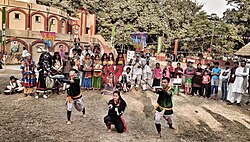This article has multiple issues. Please help improve it or discuss these issues on the talk page . (Learn how and when to remove these messages)
|

Indira Gandhi National Centre for the Arts (IGNCA), New Delhi is a premier government-funded arts organization in India. It is an autonomous institute under the Ministry of Culture. [1] [2]
Contents

